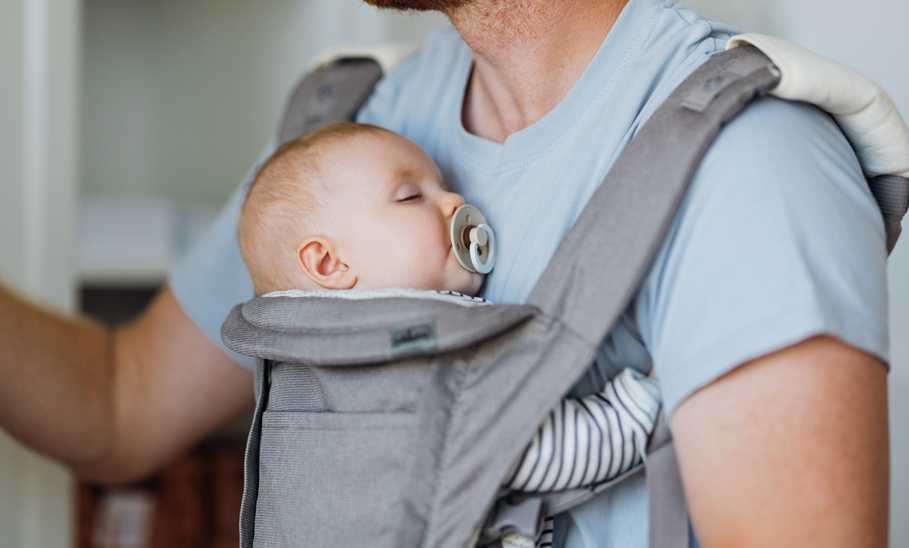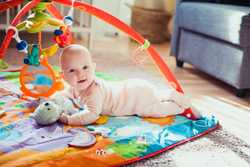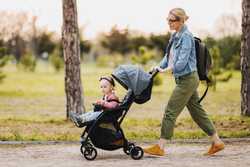Whether you want to lull your little one to sleep, log some steps, or travel with your baby, a good baby carrier is a must. “I have always been a big advocate of baby-wearing, encouraging young infants to be carried as much as possible,” says board-certified pediatrician Dr. David Berger, founder of health education company Dr. David, MD and family practice Wholistic Pediatrics & Family Care. “Being close to a parent’s chest provides both warmth and the familiarity of a heartbeat, which was the rhythm the baby heard prior to being born. It also allows the person wearing the baby to be hands-free, allowing other tasks to be performed.” There’s a lot to consider when shopping for a baby carrier. Here, I consulted the experts to develop this list of the best ones.
Our top picks for best baby carriers
![[object Object] [object Object]](https://i5.walmartimages.com/seo/Infantino-Flip-4-in-1-Convertible-Baby-Carrier-4-Position-8-32lb-Black_4fe9e5aa-ce65-4f18-b9c9-fb30a178b70c.9f342a136190745c65dc35e400e236c1.jpeg?odnHeight=640&odnWidth=640&odnBg=FFFFFF)
Infantino Flip 4-in-1 Convertible Carrier
37% offSave $14
Director of Operations of Fourth Trimester Postnatal Retreat Katie Billingsley recommends this carrier for those looking for a well-priced option. Affordable and adorable, this carrier is ideal for those on a budget. It offers four ways to carry, including facing-in (folded), facing-in (extended), facing out, and backpack, and can be used until your child is three and a half years old. You can use the folded seat position and padded head support to ergonomically hold small infants from knee to knee. Then, switch to the extended position to continue to provide a wide, ergonomic seat as your child grows. This carrier includes the handy Wonder Cover bib to protect your clothing and carrier. I’ve personally tested this carrier out and was impressed by its level of comfort despite its wallet-friendly price.
Specifications
- Material: Cotton and polyester blend
- Carry modes: Four positions — facing-in narrow seat, facing-in wide seat, facing-out, and back carry
- Waistband range: 26 inches to 52 inches
- Carrier weight: 1.2 pounds
- Child age: 0 to 42 months
- Child weight: 8 - 32 pounds
- Available positions for baby: Facing-in (narrow seat), facing-in (wide seat), facing-out, and back carry
- Color: Available in 7 colors
- FAA certified: No
- Price on publish: $32.98
Pros:
- Budget-friendly
- Lightweight
- Versatile
Cons:
- Less supportive compared to some higher-end carriers
- Not FAA certified
The bottom line:
For under $35, this carrier is a solid choice for parents on a budget or for those looking for a second carrier for another parent.
![[object Object] [object Object]](https://babytula.com/cdn/shop/products/lite-baby-carrier-discover-1_823x.jpg?v=1679954372)
Baby Tula Lite Compact Baby Carrier
Ideal for trips long and short, this cute carrier comes in a variety of adorable prints; I’m especially enamored with the star-spangled one. Billingsley likes that the Baby Tula Lite Compact Carrier even includes a waistband hip pouch for on-the-go convenience. It’s about efficiency, including only the features you need for a comfortable, ergonomic carrier.
Specifications
- Material: Lightweight, breathable blend of cotton and mesh
- Carry modes: Front and back carry
- Waistband range: 26 inches to 52 inches
- Carrier weight: 1.5 pounds
- Child age: 4 months to 2 years
- Child weight: 12 - 30 pounds
- Available positions for baby: Front and back
- Color: Available in 7 colors and patterns
- FAA certified: No
- Price on publish: $89
Pros:
- Light and portable
- Doesn’t make the child too warm
- Cute designs in a wide variety of prints and colors
- Added waistband hip pouch to carry snacks or other necessities
The bottom line:
Parents in warmer climates who need a breathable carrier, and families who travel frequently and want an easy-to-pack option will love this simpler, lightweight carrier.
![[object Object] [object Object]](https://n.nordstrommedia.com/id/sr3/5d337199-7ab4-4502-85a6-e5bb987b16cf.jpeg?crop=pad&w=780&h=1196)
Thule Sapling Child Carrier Backpack
21% offSave $80
Being a parent doesn’t mean you have to give up your favorite activities. This backpack, while expensive, lets you explore together with your little one. It’s a comfy and versatile carrier made to withstand even the most intense hikes. Embrace adventures big and small, carrying your little one (aged six months to two years) close while keeping your hands free to explore the world together.
Specifications
- Material: Aluminum frame, recycled polyester (free of PFCs)
- Carry modes: Back carry only
- Waistband range: 26 inches to 52 inches
- Carrier weight: 7 pounds
- Child age: 6 months to 2 years old
- Child weight: 16 - 48.5 pounds
- Available positions for baby: Back carry only
- Color: Agave Green and Black
- FAA certified: No
- Price on publish: $379.95
Pros:
- Durable
- Removable and machine-washable child seat makes cleaning up messes easy
- UPF 50 sunshade
- Integrated storage compartment for accessing gear on the go
Cons:
- Bulkier design
- Only one position for the child
- Not FAA certified
The bottom line:
This hiking carrier has a bevy of features that prioritize comfort, convenience, and safety that come at a higher price point, but reviewers say it’s worth it.
![[object Object] [object Object]](https://i5.walmartimages.com/seo/TwinGo-Carrier-Air-Model-Cool-Grey-Great-All-Seasons-Breathable-Mesh-Fully-Adjustable-Tandem-2-Single-Baby-Men-Woman-Twins-Babies-10-45-lbs_36fa6721-c01b-42ec-91ee-43708a332ae6.8149b22d9fc6831b47f15c990a6068e7.jpeg?odnHeight=640&odnWidth=640&odnBg=FFFFFF)
TwinGo Carrier Air Model
If you’re toting twins around, your carrier needs to be extra supportive, sturdy, and durable. This one from TwinGo is an Overall Best Pick for Amazon and boasts 4.5 stars. It’s adjustable and versatile, just like parents of twins need to be at any moment. One adult can wear two babies in the tandem position or divide the TwinGo into two individual carriers for two adults to wear one baby each (front or back positions). It works for twins and children of different sizes.
Specifications
-
Material: Breathable mesh and 100% cotton fabric
-
Carry modes:
-
Waistband range: 26 inches to 100 inches
-
Carrier weight: 3.76 pounds
-
Child age: N/A
-
Child weight: 10 - 45 pounds
-
Available positions for babies: As listed above under Carry modes
-
Color: Cool Gray, Black/Orange/Blue, Modern Teal
-
FAA certified: No
-
Price on publish: $229.99
Pros:
- Convertible — splits into two single carriers for individual babywearing
- Offers ergonomic support for both parent and baby
- Easy to use
- An alternative to double strollers
Cons:
- Somewhat expensive, but about what you’d pay on average for two separate carriers
The bottom line:
This convertible, supportive carrier can be split into two separate ones and is user-friendly for harried parents of twins.
![[object Object] [object Object]](https://images.ctfassets.net/50gzycvace50/a5a8676f83d24f13fe81eb91a76b9db321bb97df125828c2aec73c240fdfd66e/7653ffd1870c1413b49cc2f2f71711e6/a5a8676f83d24f13fe81eb91a76b9db321bb97df125828c2aec73c240fdfd66e.png?fl=progressive&fm=jpg&bg=rgb:f9f9f9&w=620&h=620)
Happy Baby Original Baby Carrier
Finding the best baby carrier for petite moms involves prioritizing comfort and adjustability. This one from Happy Baby was highly recommended by moms 5 foot 2 inches and under, thanks to its adjustable waistband.
Specifications
- Material: Linen, sustainably sourced and custom woven for softness and breathability
- Carry modes: Front (inward facing) and back
- Waistband range: 27 inches to 54 inches
- Carrier weight: 1.8 pounds
- Child age: 7 months to 4 years old
- Child weight: 7 - 45 pounds
- Available positions for baby: Front (inward facing) and back
- Color: Graphite, Fog, Almond
- FAA certified: No
- Price on publish: $169
Pros:
- Lightweight and breathable
- Easy to use
- Supportive waistband
- Adjustable—wide waistband range accommodates various body types, including petite moms
Cons:
- Higher end of the price range
- Not FAA certified
The bottom line:
The Happy Baby Original Carrier is particularly suitable for petite moms due to its adjustable waistband and streamlined design.
![[object Object] [object Object]](https://www.lillebaby.com/cdn/shop/products/AllSeasons_Moonbeam_Front_Down.jpg?v=1675297081&width=1080)
LÍLLÉbaby Complete All-Seasons
The LÍLLÉbaby Complete All-Seasons is renowned for its padded lumbar support, adjustable straps, and breathable mesh for hot climates. The design allows you to comfortably carry a child up to 45 pounds, and it also earned the approval from the International Hip Dysplasia Institute as a hip-healthy carrier. The color options are also a little more stylish than the usual black or gray options.
Specifications
- Material: 100% cotton twill and polyester mesh
- Carry modes: Six positions:
- Front-inward facing
- Front-outward facing (for older babies)
- Hip carry
- Back carry
- Fetal position (for newborns)
- Kangaroo carry (for toddlers)
- Waistband range: 26 inches to 52 inches
- Carrier weight: 1.32 pounds
- Child age: 7 months to 4 years old
- Child weight: 7 - 45 pounds
- Available positions for baby: 6 positions as listed above
- Color: Multiple color options available
- FAA certified: No
- Price on publish: $99.99 - $139.99 depending on color/print
Pros:
- Offers six carrying positions for different stages and preferences
- Padded shoulder straps and adjustable lumbar support promote comfort during extended wear
- Wear straps straight or crossed
- Acknowledged as a hip-healthy carrier by the International Hip Dysplasia Institute
Cons:
- Bulkier than some carriers
- Not FAA certified
- May require practice for some of the carry types
The bottom line:
Great for those with back pain, the LÍLLÉbaby Complete All-Seasons is a versatile and supportive carrier, offering a variety of carrying options for a wide age range.
Best baby carrier for hot weather: Integra Baby Carrier Solar
![[object Object] [object Object]](https://www.littlezenone.com/cdn/shop/products/integra-baby-carrier-solar-pastel-bluebuckle-carrierlittle-zen-one-795539.jpg?crop=center&height=999&v=1696550727&width=999)
Integra Baby Carrier Solar
For the summer and beach, Billingsley recommends this carrier. “if you are looking for a carrier with buckles that you can wear on the hottest days, even in the water, look no further than the Integra Solar,” she says. “The fabric of this carrier is designed to breathe and to dry quickly, and the cross-back straps make it a breeze to pop on and off.” It comes in three sizes for children of multiple ages.
Specifications
- Material: 100% UPF 50+ sun-protective fabric
- Carry modes: Front carry (inward facing) and back carry
- Waistband range: 26 inches to 60 inches
- Carrier weight: 1.3 pounds
- Child age: Suitable from birth (with infant insert for smaller babies) to approximately 6 years old
- Child weight: 7.5 - 53 pounds
- Available positions for baby: Front carry (inward facing) and back carry
- Color: Wide range of colors and patterns
- FAA certified: No
- Price on publish: $142 - $155 depending on size
Pros:
- UPF 50+ shields your baby from harmful UV rays
- Lightweight and breathable
- Both shoulder and waist straps are simple to tighten and adjust for a secure fit
Cons:
- Not as padded
- Not FAA certified
The bottom line:
The Integra Solar is an excellent choice for parents seeking a versatile, lightweight, and sun-protective carrier for hot climates.
![[object Object] [object Object]](https://babytula.com/cdn/shop/files/baby-carrier-exp-coast-urbanista-prod-01_1000x1500_1773aeee-9af4-4c78-944f-19ddeb17f285_823x.jpg?v=1693314688)
Tula Mesh Explore Baby Carrier
I personally tested the Tula Explore Mesh Baby Carrier and was impressed by its stylish profile and comfort. It’s versatile enough to adapt to a growing child and provides three carrying positions (front-facing in, front-facing out, and back carry) for a range of ages and development.
Specifications
- Material: 100% cotton
- Carry modes: Three positions: front-facing in, front-facing out, and back carry
- Waistband range: 27 inches to 57 inches
- Carrier weight: 1.7 pounds
- Child age: From newborn to toddler
- Child weight: 7 - 45 pounds
- Available positions for baby:
- Front-facing in (for newborns and infants who cannot hold their heads up independently)
- Front-facing out (for older babies with good head and neck control)
- Back carry (for toddlers who can sit up unassisted)
- Color: Available in a wide variety of colors and patterns
- FAA certified: No
- Price on publish: $199
Pros:
- Soft, breathable fabric
- Padded shoulder straps
- Ergonomic design
- Multiple adjustment points allow for a snug and secure fit
- Acknowledged as a hip-healthy carrier by the International Hip Dysplasia Institute
Cons:
- Expensive
- Not FAA certified
The bottom line:
The Tula Mesh Explore Baby Carrier offers benefits like multiple carrying positions, adjustability, and an ergonomic design.
![[object Object] [object Object]](https://assets.pkimgs.com/pkimgs/ab/images/dp/wcm/202408/0130/img40o.jpg)
Ergobaby Embrace Baby Carrier
“While some of their structured carriers are certainly not wallet friendly, Tula and Ergobaby are both well-known and well-loved brands with a variety of options,” Billingsley says. These are very commonly found for low prices on reseller marketplaces, she notes. I tested this one out on my newborn and found it to be comfortable and breathable while still being super snuggly for my little one.
Specifications
- Material: Soft, cozy knit fabric (79% polyester, 17% rayon, 4% elastane and spandex)
- Carry modes: Front carry (inward facing)
- Waistband range: 22 inches to 54 inches
- Carrier weight: 1 pound
- Child age: From newborn (7-8 lbs) to approximately 18 months old
- Child weight: 7 - 25 pounds
- Available positions for baby: Front carry (inward facing)
- Color: Various colors available
- FAA certified: No
- Price on publish: $100
Pros:
- Easy to use, no complicated wrapping
- Well priced
- Soft fabric that’s OEKO-TEX® STANDARD 100 certified, ensuring no harmful substances
- Acknowledged as a hip-healthy carrier by the International Hip Dysplasia Institute
Cons:
- Not FAA certified
- Limited carry positions
The bottom line:
The ErgoBaby Embrace is perfect for parents who prioritize simplicity, softness, and ease of use during the early months.
![[object Object] [object Object]](https://assets.pkimgs.com/pkimgs/rk/images/dp/wcm/202347/0061/ergobaby-omni-breeze-carrier-3-o.jpg)
Ergobaby Omni Breeze Mesh Carrier
For babies who are calmed by long walks, this carrier is ideal. The mesh fabric keeps them cool no matter the climate where you live, plus it’s a comfortable and ergonomic carrier for the parent when they’re logging lots of steps. And if you’re getting back to running, take a look at our guide on jogger strollers.
Specifications
- Material: SoftFlex™ Mesh (100% polyester)
- Carry modes: Four positions: front-inward, front-outward, hip, and back carry.
- Waistband range: 25.75 inches to 57 inches
- Carrier weight: 2 pounds
- Child age: From newborn (with infant insert sold separately) to toddler (approximately 4 years old)
- Child weight: 7 - 45 pounds
- Available positions for baby: Front-inward, front-outward, hip, and back carry.
- Color: Multiple color options available
- FAA certified: No
- Price on publish: $200
Pros:
- Lots of positions for versatile use
- Breathable
- Sturdy waistband for support of heavier babies/children
- OEKO-TEX® STANDARD 100 certified materials
- Acknowledged as a hip-healthy carrier by the International Hip Dysplasia Institute
Cons:
- Expensive
- Not FAA certified
The bottom line:
Thanks to its padded straps and sturdy waistband, the Ergobaby Omni Breeze is ideal for parents seeking ergonomic comfort, support, and breathability, especially in warmer climates.
Best baby front carrier: Baby K’tan
![[object Object] [object Object]](https://i5.walmartimages.com/seo/Baby-K-tan-Original-Wrap-Carrier-Infant-Child-Sling-Simple-Pre-Wrapped-Holder-Babywearing-No-Tying-Rings-Carry-Newborn-35-lbs-Heather-Grey-Women-16-2_e231d621-173f-488f-b1f8-2c2c42f0b0fc.a6e9684c0919e97ae7902275b56597ff.jpeg?odnHeight=640&odnWidth=640&odnBg=FFFFFF)
Baby K’tan
“Since it was invented, I have been a big fan of the Baby K’tan due to its versatile comfort in wearing, and that there are organic cotton options,” Dr. Berger says. “The inventor created this because she had a baby with Down Syndrome and she could not find a baby carrier that offered her baby enough back and neck support.” Most babies with Down Syndrome have low muscle tone. “So she and her partner set off to invent a carrier that would work!” This one is ideal if you want a wrap-style baby carrier without having to do the whole wrap thing.
Specifications
- Material: 100% cotton
- Carry modes: Five positions
- Waistband range: Sizes XXS - XL
- Carrier weight: 1.28 pounds
- Child age: Babies up to toddlerhood
- Child weight: 8 - 35 pounds
- Available positions for baby: Kangaroo, hug, explore, hip, and adventure
- Color: Multiple colors available
- FAA certified: No
- Price on publish: $59.95
Pros:
- Simple design: This is quick and easy to wear
- Offers five different positions for baby
- Budget-friendly
- Soft, flexible fabric
- Acknowledged as a hip-healthy carrier by the International Hip Dysplasia Institute
Cons:
- Not FAA certified
- Not great for extremely hot climates, but there’s a Breeze iteration that is
The bottom line:
With five different positioning options for baby, the Baby K’tan is ideal for parents looking for a simple, no-fuss babywearing option.
![[object Object] [object Object]](https://www.bumpsuit.co/cdn/shop/files/Bumpsuit_03_03_23_Armadillo_Slate_2294.jpg?v=1699920557)
Bumpsuit Armadillo Baby Carrier
I’d seen this super chic baby carrier all over my Instagram feed and it took a little digging, but I figured out that it’s from Bumpsuit. And then I saw it costs $275 and wondered how this carrier could be so wildly popular at that price. Well, then I tried it. It’s gorgeous, comfortable, comes in a variety of sleek muted tones, and adds to any ensemble, instead of, well, looking serviceable, like many carriers. I was extremely impressed with this carrier which is comfortable enough to tote my 13-pound son in for hours on end while I work from home.
Specifications
- Material: Plush boucle (100% polyester)
- Carry modes: Parent and outward facing. Outward facing recommended for 6 months and up
- Waistband range: up to 49 inches
- Carrier weight: N/A
- Child age: Newborn to 2 years old
- Child weight: 7 - 45 pounds
- Available positions for baby: Parent and outward facing. Outward facing recommended for 6 months and up
- Color: 10 colors
- FAA certified: N/A
- Price on publish: $275
Pros:
- Super stylish
- Soft
- Features a sun shade and phone pocket
- Exceedingly comfortable for you and your baby
Cons:
- Expensive
- Some colors are listed as spot clean only while others are machine wash cold
The bottom line:
It’s not wallet-friendly, but I and many, many reviewers hail this the best carrier of all — and worth the price for a durable carrier that will last until your little one is two years old or 45 pounds.
Best baby wrap carrier: Hope & Plum Hemp Blend Ring Sling
![[object Object] [object Object]](https://www.hopeandplum.co/cdn/shop/files/luna-ring-sling-made-baby-carriers-713.webp?v=1698067307&width=600)
Hope & Plum Hemp Blend Ring Sling
Billingsley especially likes this one for preemies. “While many wraps and carriers are safety tested for 7+ lbs, a ring sling can work for the tiniest of babies,” she says. “Even better, as baby grows, a ring sling can also accommodate an off-center or hip carry, which is a breeze for quick toddler ups and downs.” The Ring Sling is luxuriously soft right out of the box, and the fabric is double-layered for extra support, Billingsley reports. “Hope & Plum carriers are also all handmade in Minnesota, and the brand is known for their size inclusivity,” she says.
Specifications
- Material: Most Hope & Plum Ring Slings are made from their signature blend of hemp and organic cotton. They also offer a line of ring slings made from linen and cotton
- Carry modes: Front carry
- Waistband range: Product is available in three lengths — 74 inches, 84 inches, and 94 inches
- Carrier weight: N/A
- Child age: Newborn to toddler — suitable for babies from birth (with proper head and neck support) up to 35 pounds
- Child weight: 8 - 35 pounds
- Available positions for baby: Front carry
- Color: Comes in a wide variety of colors and prints
- FAA certified: No
- Price on publish: $105 to $155
Pros:
- Can be used to carry babies from birth to toddlerhood in a comfortable cradle position
- Comfortable — the soft fabric conforms to your body and baby
- One-size-fits-most design allows for easy adjustment to fit different body types
Cons:
- Not FAA certified
- Single carrying position
- Not as supportive
The bottom line:
The Ring Sling mimics a wrap carrier without the fuss of one, offers close physical contact, and promotes bonding but requires practice and proper positioning.
How we tested and selected the best baby carriers
I personally tested out many of the items on this list with my six-week-old baby son to see how each held up in terms of comfort, durability, and ease of use. I also considered the features parents value most, in addition to reading reviews and interviewing a pediatrician and baby expert about their input and recommendations.
What to consider when buying a baby carrier
Baby carriers are an excellent alternative to travel strollers, however, they won’t replace a baby or toddler car seat. Choosing the right baby carrier requires a few considerations to ensure it's safe, comfortable, and fits your lifestyle. Here's a breakdown of key areas to consider.
Safety
Dr. Berger says that when shopping for baby carriers, one of the most important things to consider is safety of the infant. Ensure that your baby fits well into the carrier of your choice, that nothing pinches them, and that the baby’s weight is properly supported. You want to make sure that all buckles and fasteners are in good condition and that you put the carrier on correctly. This can be surprisingly complicated when you first set it up, so consult the manufacturer's directions as needed.
Comfort
Comfort for the person carrying the baby is also a key factor, Dr. Berger says. Make sure you find a carrier that doesn’t dig into your shoulders or midsection when you’re carrying your little one. Look for padded shoulder straps, a supportive waist belt, and breathable fabrics for both you and your baby. Ensure the carrier fits properly.
Comfort for your baby is also important. Opt for ergonomic designs that support your baby's hips and spine in a healthy position, particularly for newborns.
Baby's age and weight
- Newborn ready: Carriers designed specifically for newborns often have an insert or support system to accommodate their small size and developing bodies.
- Baby's weight range: Check the carrier's weight limits and ensure it'll support your baby as they grow.
Carrying positions
Front-facing in: Great for bonding with your baby and allowing them to observe their surroundings.
Front-facing out: Offers babies a different point of view, but not all experts recommend this for long periods due to hip position concerns.
Back carrying: Ideal for heavier babies when front carrying becomes tiring.
Hip carrying: Perfect for quick in-and-out carrying with toddlers.
Ease of use
- Adjustability: Choose a carrier with adjustable straps that allow for easy switching between parents or caregivers of different sizes.
- Intuitive buckles and straps: Consider how easy the carrier is to put on, adjust, and take off while holding or wearing your baby.
Lifestyle
- Versatility: If you're looking for a carrier for different uses (e.g., hiking, errands, travel), choose a versatile design with a variety of carrying positions and features.
- Lightweight and portable: If you frequently travel or need a carrier that takes up minimal space, consider lightweight carriers or those that fold down compactly.
Material
Choose comfortable and breathable fabrics like cotton or mesh, especially for hot climates.
Machine washable
Look for a machine-washable carrier for easy cleaning.
Safety certifications
Ensure any carrier you consider has appropriate safety certifications and adheres to safe carrying practices. If possible, always try on a carrier before purchasing to ensure a proper fit and adjustability for both you and your baby.
How to maintain and clean a baby carrier
To maintain and clean your baby carrier, always check the care tag for specific instructions. For general cleaning, spot clean minor messes with a damp cloth and mild soap. If machine washable, use cold water, mild detergent, and a mesh bag. Air dry the carrier flat to avoid damage. Regularly clean accessories, address spills promptly, and avoid harsh chemicals. Remember, the manufacturer's instructions are key, and specific cleaning methods may vary based on the materials used.
Frequently asked questions (FAQs)
What is the best baby carrier to buy during pregnancy?
There isn't one single "best" baby carrier for pregnancy. The ideal carrier depends on your individual needs, stage of pregnancy, and what you prioritize in terms of comfort and support.
Is it worth getting a baby carrier?
Yes! For most parents, a baby carrier is a worthwhile investment. It promotes bonding, soothes fussiness, frees up your hands (a huge plus), offers more convenience for walks and errands than a stroller, and provides ergonomic support for your baby.
Can I use a baby carrier for a newborn?
Dr. Berger says to check on the individual product, but most baby carriers can be used for seven pounds and above. “If using one in which the baby lays down as opposed to being upright, make sure the baby’s back does not curl in a C-shape position,” he explains.
Which baby carrier is safest?
“Carriers that are safest allow the baby’s neck to be straight and the head above the fabric, not buried inside,” Dr. Berger says. “It is important to make sure that the carrier is the right size for the baby and that it supports the baby’s back.”
The information presented here is created by TIME Stamped and overseen by TIME editorial staff. To learn more, see our About Us page.


![[object Object] [object Object]](https://i5.walmartimages.com/seo/Infantino-Flip-4-in-1-Convertible-Baby-Carrier-4-Position-8-32lb-Black_4fe9e5aa-ce65-4f18-b9c9-fb30a178b70c.9f342a136190745c65dc35e400e236c1.jpeg?odnHeight=640&odnWidth=640&odnBg=FFFFFF)
![[object Object] [object Object]](https://babytula.com/cdn/shop/products/lite-baby-carrier-discover-1_823x.jpg?v=1679954372)
![[object Object] [object Object]](https://n.nordstrommedia.com/id/sr3/5d337199-7ab4-4502-85a6-e5bb987b16cf.jpeg?crop=pad&w=780&h=1196)
![[object Object] [object Object]](https://i5.walmartimages.com/seo/TwinGo-Carrier-Air-Model-Cool-Grey-Great-All-Seasons-Breathable-Mesh-Fully-Adjustable-Tandem-2-Single-Baby-Men-Woman-Twins-Babies-10-45-lbs_36fa6721-c01b-42ec-91ee-43708a332ae6.8149b22d9fc6831b47f15c990a6068e7.jpeg?odnHeight=640&odnWidth=640&odnBg=FFFFFF)
![[object Object] [object Object]](https://images.ctfassets.net/50gzycvace50/a5a8676f83d24f13fe81eb91a76b9db321bb97df125828c2aec73c240fdfd66e/7653ffd1870c1413b49cc2f2f71711e6/a5a8676f83d24f13fe81eb91a76b9db321bb97df125828c2aec73c240fdfd66e.png?fl=progressive&fm=jpg&bg=rgb:f9f9f9&w=620&h=620)
![[object Object] [object Object]](https://www.lillebaby.com/cdn/shop/products/AllSeasons_Moonbeam_Front_Down.jpg?v=1675297081&width=1080)
![[object Object] [object Object]](https://www.littlezenone.com/cdn/shop/products/integra-baby-carrier-solar-pastel-bluebuckle-carrierlittle-zen-one-795539.jpg?crop=center&height=999&v=1696550727&width=999)
![[object Object] [object Object]](https://babytula.com/cdn/shop/files/baby-carrier-exp-coast-urbanista-prod-01_1000x1500_1773aeee-9af4-4c78-944f-19ddeb17f285_823x.jpg?v=1693314688)
![[object Object] [object Object]](https://assets.pkimgs.com/pkimgs/ab/images/dp/wcm/202408/0130/img40o.jpg)
![[object Object] [object Object]](https://assets.pkimgs.com/pkimgs/rk/images/dp/wcm/202347/0061/ergobaby-omni-breeze-carrier-3-o.jpg)
![[object Object] [object Object]](https://i5.walmartimages.com/seo/Baby-K-tan-Original-Wrap-Carrier-Infant-Child-Sling-Simple-Pre-Wrapped-Holder-Babywearing-No-Tying-Rings-Carry-Newborn-35-lbs-Heather-Grey-Women-16-2_e231d621-173f-488f-b1f8-2c2c42f0b0fc.a6e9684c0919e97ae7902275b56597ff.jpeg?odnHeight=640&odnWidth=640&odnBg=FFFFFF)
![[object Object] [object Object]](https://www.bumpsuit.co/cdn/shop/files/Bumpsuit_03_03_23_Armadillo_Slate_2294.jpg?v=1699920557)
![[object Object] [object Object]](https://www.hopeandplum.co/cdn/shop/files/luna-ring-sling-made-baby-carriers-713.webp?v=1698067307&width=600)



